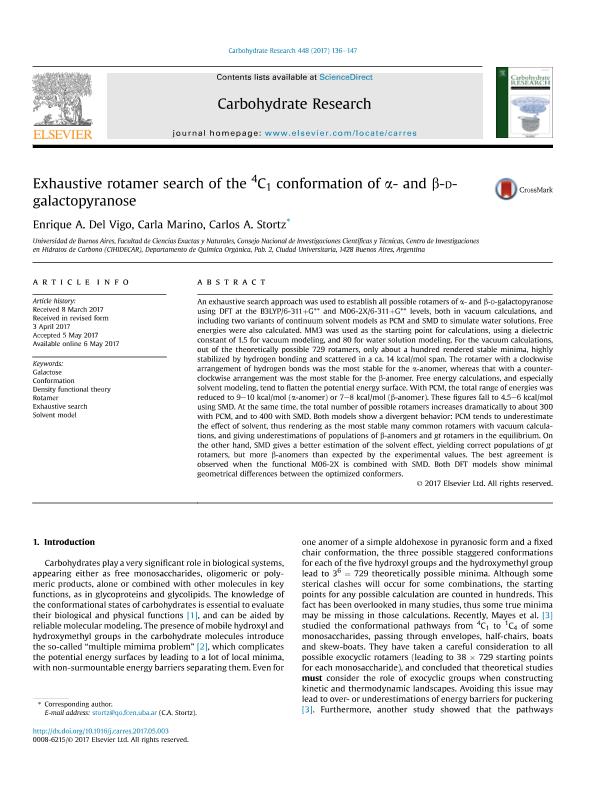Mostrar el registro sencillo del ítem
dc.contributor.author
del Vigo, Enrique Andres

dc.contributor.author
Marino, María Carla

dc.contributor.author
Stortz, Carlos Arturo

dc.date.available
2018-11-09T19:18:25Z
dc.date.issued
2017-05
dc.identifier.citation
del Vigo, Enrique Andres; Marino, María Carla; Stortz, Carlos Arturo; Exhaustive rotamer search of the 4C1 conformation of α- and β-D-galactopyranose; Elsevier; Carbohydrate Research; 448; 5-2017; 136-147
dc.identifier.issn
0008-6215
dc.identifier.uri
http://hdl.handle.net/11336/64131
dc.description.abstract
An exhaustive search approach was used to establish all possible rotamers of α- and β-D-galactopyranose using DFT at the B3LYP/6-311+G** and M06-2X/6-311+G** levels, both in vacuum calculations, and including two variants of continuum solvent models as PCM and SMD to simulate water solutions. Free energies were also calculated. MM3 was used as the starting point for calculations, using a dielectric constant of 1.5 for vacuum modeling, and 80 for water solution modeling. For the vacuum calculations, out of the theoretically possible 729 rotamers, only about a hundred rendered stable minima, highly stabilized by hydrogen bonding and scattered in a ca. 14 kcal/mol span. The rotamer with a clockwise arrangement of hydrogen bonds was the most stable for the α-anomer, whereas that with a counterclockwise arrangement was the most stable for the β-anomer. Free energy calculations, and especially solvent modeling, tend to flatten the potential energy surface. With PCM, the total range of energies was reduced to 9–10 kcal/mol (α-anomer) or 7–8 kcal/mol (β-anomer). These figures fall to 4.5–6 kcal/mol using SMD. At the same time, the total number of possible rotamers increases dramatically to about 300 with PCM, and to 400 with SMD. Both models show a divergent behavior: PCM tends to underestimate the effect of solvent, thus rendering as the most stable many common rotamers with vacuum calculations, and giving underestimations of populations of β-anomers and gt rotamers in the equilibrium. On the other hand, SMD gives a better estimation of the solvent effect, yielding correct populations of gt rotamers, but more β-anomers than expected by the experimental values. The best agreement is observed when the functional M06-2X is combined with SMD. Both DFT models show minimal geometrical differences between the optimized conformers.
dc.format
application/pdf
dc.language.iso
eng
dc.publisher
Elsevier

dc.rights
info:eu-repo/semantics/openAccess
dc.rights.uri
https://creativecommons.org/licenses/by-nc-nd/2.5/ar/
dc.subject
Conformation
dc.subject
Density Functional Theory
dc.subject
Exhaustive Search
dc.subject
Galactose
dc.subject
Rotamer
dc.subject
Solvent Model
dc.subject.classification
Otras Ciencias Químicas

dc.subject.classification
Ciencias Químicas

dc.subject.classification
CIENCIAS NATURALES Y EXACTAS

dc.title
Exhaustive rotamer search of the 4C1 conformation of α- and β-D-galactopyranose
dc.type
info:eu-repo/semantics/article
dc.type
info:ar-repo/semantics/artículo
dc.type
info:eu-repo/semantics/publishedVersion
dc.date.updated
2018-10-23T18:12:25Z
dc.journal.volume
448
dc.journal.pagination
136-147
dc.journal.pais
Países Bajos

dc.journal.ciudad
Amsterdam
dc.description.fil
Fil: del Vigo, Enrique Andres. Consejo Nacional de Investigaciones Científicas y Técnicas. Oficina de Coordinación Administrativa Ciudad Universitaria. Centro de Investigaciones en Hidratos de Carbono. Universidad de Buenos Aires. Facultad de Ciencias Exactas y Naturales. Centro de Investigaciones en Hidratos de Carbono; Argentina
dc.description.fil
Fil: Marino, María Carla. Consejo Nacional de Investigaciones Científicas y Técnicas. Oficina de Coordinación Administrativa Ciudad Universitaria. Centro de Investigaciones en Hidratos de Carbono. Universidad de Buenos Aires. Facultad de Ciencias Exactas y Naturales. Centro de Investigaciones en Hidratos de Carbono; Argentina
dc.description.fil
Fil: Stortz, Carlos Arturo. Consejo Nacional de Investigaciones Científicas y Técnicas. Oficina de Coordinación Administrativa Ciudad Universitaria. Centro de Investigaciones en Hidratos de Carbono. Universidad de Buenos Aires. Facultad de Ciencias Exactas y Naturales. Centro de Investigaciones en Hidratos de Carbono; Argentina
dc.journal.title
Carbohydrate Research

dc.relation.alternativeid
info:eu-repo/semantics/altIdentifier/doi/http://dx.doi.org/10.1016/j.carres.2017.05.003
dc.relation.alternativeid
info:eu-repo/semantics/altIdentifier/url/https://www.sciencedirect.com/science/article/pii/S000862151730191X
Archivos asociados
